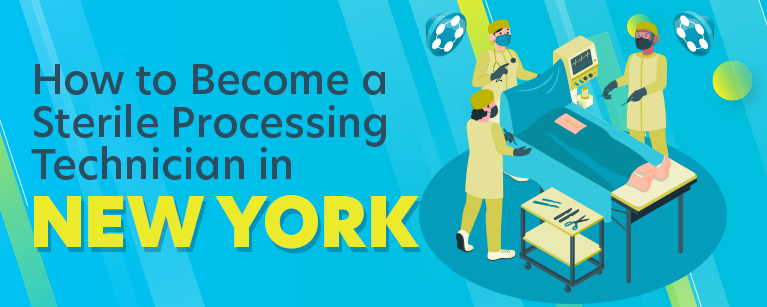
The medical community would be lost without sterile processing technicians.
They’re responsible for cleaning, sterilizing, setting up, and maintaining medical equipment and supplies – preventing the spread of infection, illness, and disease in hospitals, medical facilities, research laboratories, and surgery centers across the country.
This might be your calling if you’re looking for a respected career in the medical field.
Table of Contents
How to Become a Sterile Processing Technician – Step by Step
The process for becoming a sterile processing technician in New York isn’t much different than in other parts of the country.
A state-issued license isn’t needed, but aspiring SPTs are expected to have a high school diploma (or GED), postsecondary training, internship experience, and a national certification.
Most employers in the state require sterile processing technicians to have a combination of in-classroom learning and on-the-job experience – which can take anywhere from one to three years to obtain.
Don’t worry; we’ll detail everything you need to know about becoming a sterile processing technician.
Graduate High School or Pass the GED Exam
Most training programs and internships require aspiring SPTs to be at least 18 years old and have a high school diploma or New York State High School Equivalency (HSE) Diploma.
A high school education proves that you have a basic understanding of medical concepts and terminology used in the industry.
There’s only one way to earn an HSE diploma in NY, and that’s after passing the General Educational Development Test (GED® Test) – which replaced the Test Assessing Secondary Completion (TASC™ Test) in January 2022.
It costs $119 per subject (4 subjects), but you can purchase them all for $389.
Enroll in Postsecondary Training Program
Once you have the basic knowledge to advance, it’s time to gain some technical knowledge in the field.
While not always necessary (depending on the employer), the best way to get your feet wet in the industry is by enrolling in a postsecondary training program that generally lasts 1-2 years.
Here are the most prominent schools and organizations offering SPT training programs in New York:
- Long Island University
- Swedish Institute College of Health Sciences
- Capital Region BOCES
- Rochester Educational Opportunity Center
- University at Buffalo
Most postsecondary training programs combine in-classroom learning with hands-on experience to ensure students understand what to do and how to do it.
100% of the skills and knowledge gained in the postsecondary training program can and will be applied to your future as an SPT.
Find Internship Opportunities
Now that you’ve completed your postsecondary training program, you get to put what you learned to the test as an intern.
Most internships are 400 hours, generally at hospitals, medical facilities, research laboratories, and surgery centers – the same places you’ll be working at.
Finding the right internship might take time, but you could also use your network of friends, educators, and other SPT professionals you met along the way to see if they know of any opportunities in the New York area.
Some organizations will list their internships online (on their website or job search engines).
Pass National Certification Exam
New York State doesn’t issue licenses for sterile processing technicians or require them to obtain any certifications before working as an SPT in the state.
With that said, most employers have their own requirements and will ask you to pass a national certification exam before beginning work in the field.
There are two accrediting bodies for sterile processing technicians in the United States today:
- Healthcare Sterile Processing Association (HSPA)
- Certification Board for Sterile Processing and Distribution (CBSPD)
The HSPA requires aspiring SPTs to have at least 400 hours of hands-on experience – either five years before the application or six months after the certification exam.
The CBSPD requires you to have at least 12 months of experience in the field or a Certificate of Completion from a training program.
Start Looking for Work in the Field
Congratulations – you’re officially a certified sterile processing technician.
You took the time to learn the trade and are now ready to master it as you embark on a new chapter in your life.
To start looking for work, we suggest looking through online job search engines or utilizing that massive network you’ve built.
Having a resume and cover letter will show employers how serious you are, but don’t be afraid to reach out to them if you don’t hear from them first – there’s nothing wrong with following up, and it might just lead to the opportunity of your life.
With that said, we wish you all the best as you begin your new career.
Sterile Processing Technician Schools in New York
Enrolling in a sterile processing technician training program is often the first step to beginning your career as an SPT.
This is where you’ll receive a combination of in-class learning and hands-on experience – as well as courses on medical terminology, medical instrumentation, and various sterilization techniques.
Most postsecondary training programs issue a Certificate of Completion or an Associate’s degree – either way, you can expect to spend 1-2 years in this stage of the journey.
Most degrees (two years) cost around $8,000, while certificates (three months to two years) generally cost anywhere from $1,500 to $7,000.
Long Island University
- Location: 1 University Plaza, Brooklyn, NY 11201
- Program: Central Service Technician
- Course Length: 80 credit hours
- Tuition Cost: $1,150
Located in the heart of Brooklyn, Long Island University offers a Central Service Technician Certificate Program comprising two 40-hour courses worth $575.
Aspiring SPTs (or, in this case, CSTs) must pass both courses if they want to earn their certificate of completion.
Swedish Institute College of Health Sciences
- Location: 151 W 26th St, New York, NY 10001
- Program: Central Service Processing Technician
- Course Length: 9 months
- Tuition Cost: about $15,000
Located just a few blocks away from the Empire State Building, the Swedish Institute College of Health Sciences offers a Central Service Processing Technician program that can be completed in as little as nine months.
It’ll prepare you for the national certification, and you’ll even complete a 420-hr externship.
Capital Region BOCES
- Location: 900 Watervliet Shaker Rd, Albany, NY 12205
- Program: Sterile Processing Technician
- Course Length: 8 months
- Tuition Cost: $4,000
Located in northern Albany, the Capital Region BOCES offers a Sterile Processing Technician program that runs from September to April – classes are in the evening (4 p.m. to 7 p.m.).
It also offers clinical experience at one of three hospitals – Albany Medical Center, Ellis Hospital, and St. Peter’s Hospital.
Rochester Educational Opportunity Center
- Location: 161 Chestnut St, Rochester, NY 14604
- Program: Sterile Processing Technician
- Course Length: n/a
- Tuition Cost: n/a
Located in the heart of Rochester, NY, the Rochester Educational Opportunity Center (REOC) offers a Sterile Processing Technician program.
To apply for admissions, aspiring technicians must be New York State residents with a minimum passing TABE Entrance Score and proof of MMR vaccination.
University at Buffalo
- Location: 190 Founders Prom, Amherst, NY 14068
- Program: Central Sterilization Technician
- Course Length: 15 weeks
- Tuition Cost: n/a
Located in Amherst, NY – on the outskirts of Buffalo, NY – the University at Buffalo offers a Central Sterilization Technician program that takes 15 weeks to complete.
Upon program completion, students receive a Certificate of Completion and a National CSPDT Certification from the CBSPD.
| School Name | Address |
|---|---|
| Long Island University | 1 University Plaza, Brooklyn, NY 11201, United States |
| Swedish Institute College of Health Sciences | 151 W 26th St, New York, NY 10001, United States |
| Capital Region BOCES | 900 Watervliet Shaker Rd, Albany, NY 12205, United States |
| Rochester Educational Opportunity Center | 161 Chestnut St, Rochester, NY 14604, United States |
| University at Buffalo | 190 Founders Prom, Amherst, NY 14068, United States |
Sterile Processing Technician Salary in New York
The average salary for a sterile processing technician in the United States is $45,322 (between $39,982 and $50,521) – don’t worry; the average salary increases to $48,363 for New York residents (between $42,665 and $53,910).
Not only is New York one of the best places to get a job as an SPT, but they offer competitive pay that most states in the US can’t duplicate.
Annual Salary Range:| Location | Avg. Annual Salary |
|---|---|
| New York | $53,253 |
| Buffalo | $44,249 |
| Rochester | $44,678 |
| Yonkers | $52,241 |
| Syracuse | $45,074 |
| Albany | $45,993 |
| New Rochelle | $51,675 |
| Mount Vernon | $52,218 |
| Schenectady | $45,881 |
| Utica | $44,125 |
Regional Salary in New York
| Region | Employed | Avg. Annual Salary | Avg. Hourly Pay | Top 10% Annual Salary | Bottom 10% Annual Salary |
|---|---|---|---|---|---|
| Albany-Schenectady-Troy, NY | 220 | $40,410 | $19.43 | $49,370 | $34,720 |
| Buffalo-Cheektowaga-Niagara Falls, NY | 330 | $43,870 | $21.09 | $53,650 | $34,150 |
| New York-Newark-Jersey City, NY-NJ-PA | 5,260 | $50,120 | $24.1 | $64,950 | $37,010 |
| Rochester, NY | 280 | $42,690 | $20.52 | $50,610 | $33,100 |
| Syracuse, NY | 190 | $43,280 | $20.81 | $56,720 | $32,530 |
| Utica-Rome, NY | 60 | $41,990 | $20.19 | $55,980 | $31,340 |
* Employment conditions in your area may vary.
Frequently Asked Questions
How long does becoming a sterile processing technician in New York take?
Most aspiring SPTs spend 1-2 years in a training program and several months in an internship before obtaining their national certification.
Can I use my SPT certification in any other state?
Since most states don’t issue licenses for SPTs and the certification is issued at a national level, you can work in any state that doesn’t issue its own license.
Where can I find a job as a sterile processing technician in New York?
The best places to work as an SPT in New York are hospitals, research laboratories, surgery centers, health clinics, and/or medical facilities.
Sterile Processing Technician Info by State
- Alabama
- Alaska
- Arizona
- Arkansas
- California
- Colorado
- Connecticut
- Delaware
- Florida
- Georgia
- Hawaii
- Idaho
- Illinois
- Indiana
- Iowa
- Kansas
- Kentucky
- Louisiana
- Maine
- Maryland
- Massachusetts
- Michigan
- Minnesota
- Mississippi
- Missouri
- Montana
- Nebraska
- Nevada
- New Hampshire
- New Jersey
- New Mexico
- New York
- North Carolina
- North Dakota
- Ohio
- Oklahoma
- Oregon
- Pennsylvania
- Rhode Island
- South Carolina
- South Dakota
- Tennessee
- Texas
- Utah
- Vermont
- Virginia
- Washington
- West Virginia
- Wisconsin
- Wyoming









